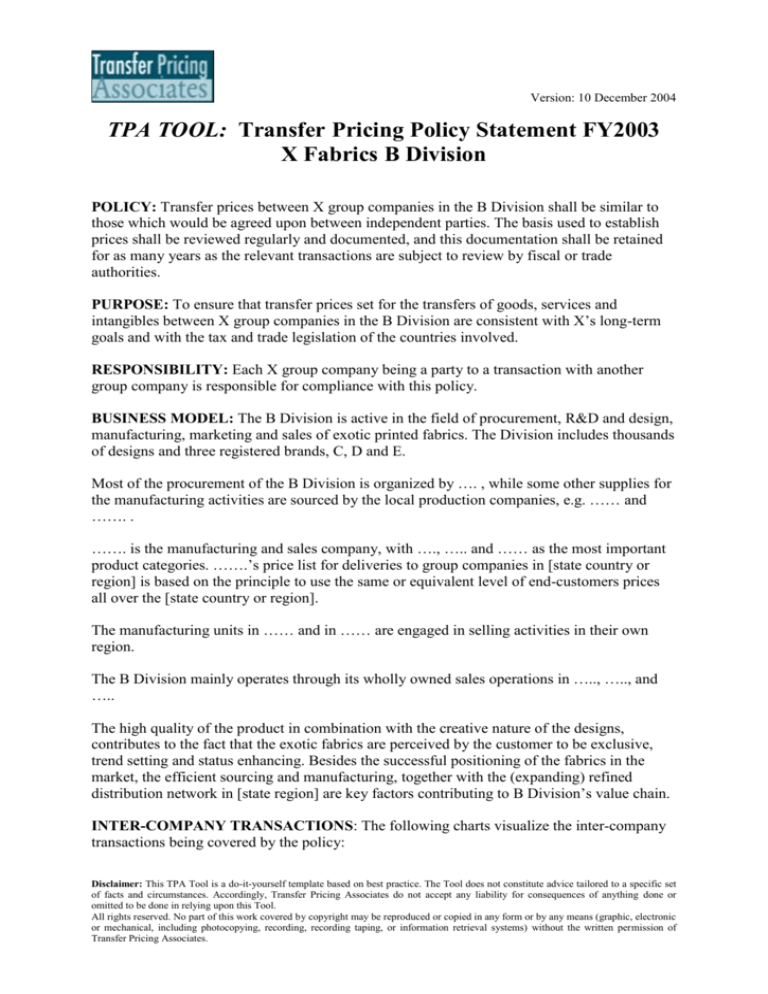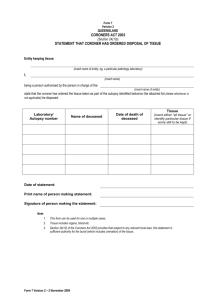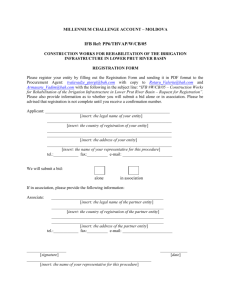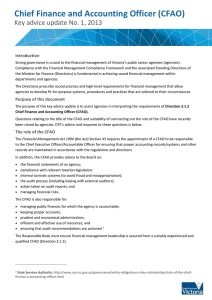
Version: 10 December 2004
TPA TOOL: Transfer Pricing Policy Statement FY2003
X Fabrics B Division
POLICY: Transfer prices between X group companies in the B Division shall be similar to
those which would be agreed upon between independent parties. The basis used to establish
prices shall be reviewed regularly and documented, and this documentation shall be retained
for as many years as the relevant transactions are subject to review by fiscal or trade
authorities.
PURPOSE: To ensure that transfer prices set for the transfers of goods, services and
intangibles between X group companies in the B Division are consistent with X’s long-term
goals and with the tax and trade legislation of the countries involved.
RESPONSIBILITY: Each X group company being a party to a transaction with another
group company is responsible for compliance with this policy.
BUSINESS MODEL: The B Division is active in the field of procurement, R&D and design,
manufacturing, marketing and sales of exotic printed fabrics. The Division includes thousands
of designs and three registered brands, C, D and E.
Most of the procurement of the B Division is organized by …. , while some other supplies for
the manufacturing activities are sourced by the local production companies, e.g. …… and
……. .
……. is the manufacturing and sales company, with …., ….. and …… as the most important
product categories. …….’s price list for deliveries to group companies in [state country or
region] is based on the principle to use the same or equivalent level of end-customers prices
all over the [state country or region].
The manufacturing units in …… and in …… are engaged in selling activities in their own
region.
The B Division mainly operates through its wholly owned sales operations in ….., ….., and
…..
The high quality of the product in combination with the creative nature of the designs,
contributes to the fact that the exotic fabrics are perceived by the customer to be exclusive,
trend setting and status enhancing. Besides the successful positioning of the fabrics in the
market, the efficient sourcing and manufacturing, together with the (expanding) refined
distribution network in [state region] are key factors contributing to B Division’s value chain.
INTER-COMPANY TRANSACTIONS: The following charts visualize the inter-company
transactions being covered by the policy:
Disclaimer: This TPA Tool is a do-it-yourself template based on best practice. The Tool does not constitute advice tailored to a specific set
of facts and circumstances. Accordingly, Transfer Pricing Associates do not accept any liability for consequences of anything done or
omitted to be done in relying upon this Tool.
All rights reserved. No part of this work covered by copyright may be reproduced or copied in any form or by any means (graphic, electronic
or mechanical, including photocopying, recording, recording taping, or information retrieval systems) without the written permission of
Transfer Pricing Associates.
Version: 10 December 2004
(a1) for services – central procurement/sourcing
[entity name] …......(recipient)
[entity name] …. …(recipient)
[entity name] ……..(recipient)
[insert summary of roles and responsibilities: e.g. [entity name] acts as a purchasing agent visà-vis the manufacturing units within the B Division. [entity name] is profit centre]
(a2) for services – technical process support services
[entity name] …......(recipient)
[entity name] …. …(recipient)
[entity name] ……..(recipient)
[insert summary of roles and responsibilities: e.g. [entity name] acts as a service provider for
the planning, design and set up of a production site, including transport, installation, quality
control on the purchase raw materials, staffing, maintenance and other operational support
services within the B Division; [entity name]’s role as service provider regarding …. also
includes allowing ……access to the B European organization. [entity name] is classified as an
expense centre]
(a3) for services – other support services
X Holding [entity name] [entity names]
[insert summary of roles and responsibilities: X Holding acts a limited services provider in the
field of tax & legal; [entity name] is the shared services centre and acts as a general service
provider covering HR support, financial services, training, etc. In these roles, both entities are
expense centres]
(b) for goods sold by [entity name]
[entity name] D (France)
[entity name] CFCI and P (sales and marketing)
[entity name] U/VT/J/N/V
[insert geographical coverage]
[insert summary of roles and responsibilities: e.g. [entity name] acts as a production unit
2
Version: 10 December 2004
selling its finished products into the Asian and European markets using affiliated sales
companies. It is classified as a cost centre]
(e) for goods sold by …..(I/C)
U D (distribution rights for all territory outside …..) Vo/J/Ne/B
[insert summary of roles and responsibilities: ….. is manufacturing and selling in …., but has
appointed …….. as the leading distributor in the group]
(c) for design rights
B BV (…) ….. and ….
[Question: Are there any other intellectual property rights – like tradenames- which are put at
the disposal of the manufacturing entities?]
[insert summary of roles: … gives the permission to … and … to print the B-designs and sell
the finished branded products in the market]
CHOICE OF PRICING METHODS: The B Division has selected the following most
appropriate pricing methods under the OECD Transfer Pricing Guidelines for each of the
inter-company transactions mentioned above:
(a) for services
Based on the functional profile of the services providers (insert total list of providers) as
expense centres a cost plus method approach is applied, except in the case of B performing a
purchasing/sourcing role.
The functional profile is B is that of a sourcing agent, which in third party situation would
typically be compensated by a percentage of the value of the purchased goods/raw materials.
[Question/remark: please specify the exception of B, i.e. it should be validated by a sound
description of its value added activities it performs on behalf of the manufacturing entities]
(b) for goods
Based on the functional profile of the B operating companies a resale minus method approach
has been applied for manufacturing transactions, leveling the end prices charged to the
ultimate customers. In most situation though, the starting point of determining the
intercompany price uses the prices charged to third parties.
The resale minus method is applied using the following quantitative references:
- for deliveries to …., ….., …… and ….: the prices charged to third parties (so called
CFAO prices); CFAO prices are the prices to the 3 largest customers of B ..... in
3
Version: 10 December 2004
-
-
-
……., and a separate CFAO price list for ….. CFAO prices are typically lower than
the ‘standard’ price lists to third parties.
For deliveries to ….. (i.e. B ..... does not deliver directly to …): the prices CFCI (….. )
charges to customers.
For deliveries to ….. (through …/…, which companies are established in Europe): the
CFAO price list.
For deliveries to ……..): the CFAO price list.
For deliveries to France (through …….): the price list to other European
wholesellers (3rd parties) minus 15%. ….. charges customers the same price as B .....
charges to its 3rd party customers in Europe. For certain categories of products other
percentages apply. The 3rd party prices in Europe by far exceed the price level in Asia.
On average the intercompany prices from B ..... to …. and are slightly lower than in
the other Asian countries, due to higher import duties and VAT levied in …… and
(i.e. to achieve the same level of customer prices).
In case of lower volumes, higher business risks (obsolescence, credit) the group
company pays a mark-up on the C or CI prices to B ..... (ranging from 2 % up to 10%)
In exceptional cases, the B Divisions’ sales operation receive a discount for
penetration purposes, e.g. …...
(c) for design rights
Based on the functional profile of B BV the charge for design rights are structured either as a
fixed amount per meter/yard or as a royalty percentage of net sales. Both methods are
acceptable from a transfer pricing perspective.
LEGAL FRAMEWORK: To capture the allocation of roles and responsibilities between the
group companies in the B Division and as part of the document of the transfer pricing system,
the following inter-company agreements are concluded:
(a) for services
B has entered into sourcing agreements with B ....., and …..
B has entered into technical services agreements for product and process support with … and
…
+ services agreements
(b) for goods
B has entered into a sales and distribution agreement with [insert the relevant group entities].
… has entered into a sales and distribution agreement with [insert the relevant group entities]
…….. has entered into a sales and distribution agreement with …..
4
Version: 10 December 2004
(c) for design rights
B BV () has entered into two contracts: ‘contrat de mise a disposition de dessins’ with …..and
a ‘design license agreements’ with …...
[place, month, year]
5








